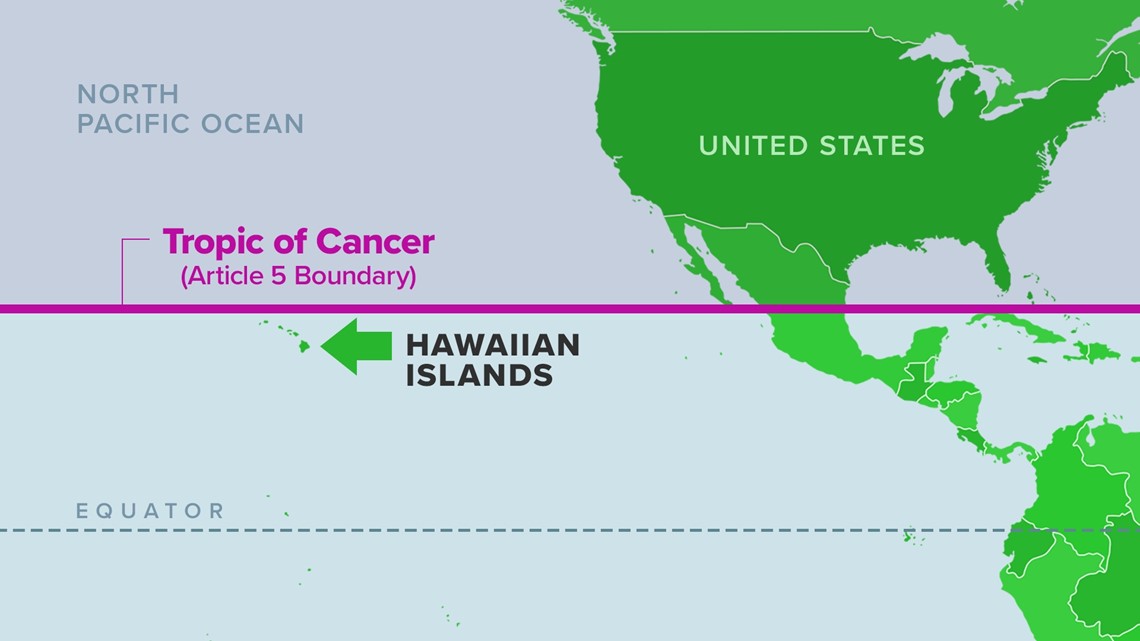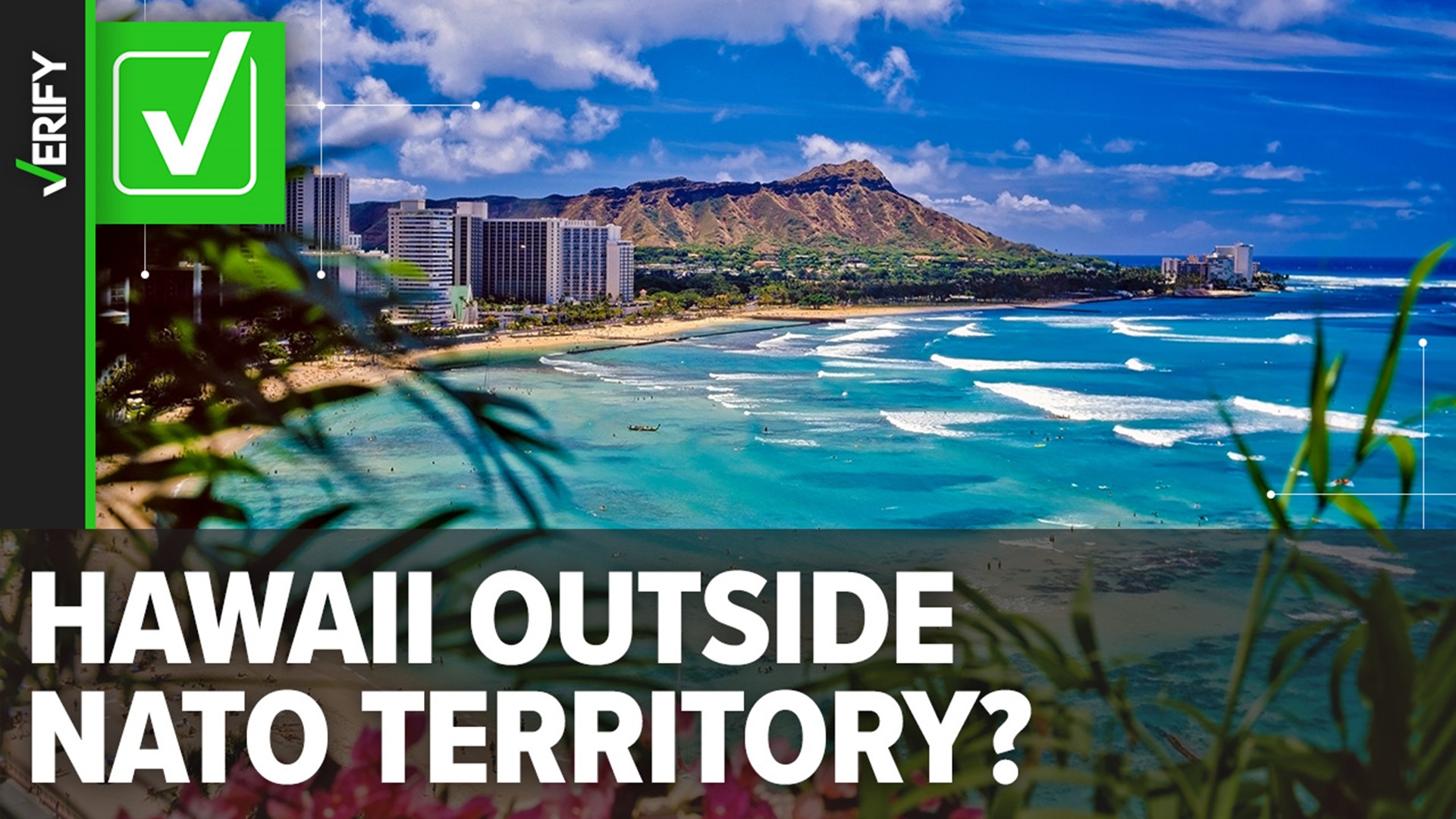Rising tensions between China and Taiwan as well as the Russia-Ukraine war have prompted concerns about security in the Pacific Ocean, including the possibility of attacks on Hawaii.
Several news outlets have reported in recent weeks that Hawaii is not covered by the North Atlantic Treaty Organization’s collective security guarantee known as Article 5, which ensures any members under attack would get protection from NATO, due to its geographical location.
These reports prompted similar claims from some Republican lawmakers on social media.
“Hawaii is not covered by the NATO treaty. Some experts say that needs to change. I say, let’s get the other 49 states out,” Rep. Thomas Massie (R-KY) said in a post on April 1.
NATO is an alliance of 32 North American and European countries, including the United States, that was created in 1949 after World War II. Member countries agree to 14 articles of the Washington Treaty, which created NATO, in order to join. Article 5 of the treaty asserts that an attack against an ally is an attack against all. That means member countries are obligated to defend an ally if there is an attack.
A Russian academic reportedly suggested his country should aim to “capture” the one U.S. state that isn’t covered by Article 5, in an apparent reference to Hawaii, according to a Newsweek article published on April 4.
The Newsweek article led VERIFY reader Susan to ask the team whether it’s true that Hawaii is excluded from NATO protections due to its location.
THE QUESTION
Is Hawaii outside of the geographical boundaries of NATO’s collective security guarantee known as Article 5?
THE SOURCES
- The North Atlantic Treaty
- U.S. State Department spokesperson
- John Hemmings, Ph.D., senior associate director at the Pacific Forum
- Robert Sanders, LP.D., distinguished lecturer of national security at the University of New Haven
- Michael O’Hanlon, Ph.D., senior fellow and director of research in Foreign Policy at the Brookings Institution
THE ANSWER
Hawaii is outside the geographical boundaries of Article 5 in the NATO treaty. But experts say an attack on the state would still likely trigger a NATO response.
WHAT WE FOUND
It is true that Hawaii is outside of the geographical boundaries of NATO’s collective security guarantee known as Article 5. That means NATO may not be technically obligated to defend the state in the event of an attack. But the U.S. State Department and other experts say an attack on Hawaii would still likely trigger a NATO response.
Hawaii didn’t become a state until Aug. 21, 1959. That’s more than 10 years after NATO was founded and the treaty was signed in April 1949.
Article 5 of the North Atlantic Treaty, which is more commonly known as the Washington Treaty, says that if a NATO ally is the victim of an armed attack, every other member of the Alliance “will consider this act of violence as an armed attack against all members and will take action it deems necessary to assist the Ally attacked,” NATO explains on its website.
But there’s a geographic exception in the treaty that excludes the Hawaiian islands.
The Washington Treaty specifies that “for the purpose of Article 5, an armed attack on one or more of the Parties is deemed to include an armed attack on the territory of any of the Parties in Europe or North America.”
It also says any “islands under the jurisdiction of any of the parties” must be “north of the Tropic of Cancer.” This would not include the Hawaiian islands, since they lie just south of the Tropic of Cancer.


“Because of these geographic restrictions, Hawaii is not covered” by Article 5, John Hemmings, Ph.D., senior associate director at the Pacific Forum, told VERIFY.
The State Department also acknowledged that Hawaii is in an area that’s not covered by Article 5 but said NATO allies would still likely respond in the event of an attack on the state.
“Any attack on the United States or its territories, even if outside of the geographic scope of Article 5, would almost certainly draw Ally reaction to include via the consultation procedures under Article 4 of the Treaty,” a spokesperson for the State Department told VERIFY.
Article 4 is one part of the treaty that suggests NATO countries would still respond in the event of an attack on Hawaii.
Under Article 4, members can bring any issues of concern, especially those related to a country’s security, to the table for discussion. This discussion can potentially lead to a joint decision or action on behalf of the Alliance, NATO explains.
“The Parties will consult together whenever, in the opinion of any of them, the territorial integrity, political independence or security of any of the Parties is threatened,” the article states.
Article 4 has been invoked seven times since the Alliance’s creation in 1949, though never by the United States, according to NATO.
It isn’t the only reason why NATO would likely come to Hawaii’s defense in the event of an attack, though.
Robert Sanders, LP.D., a distinguished lecturer of national security at the University of New Haven, said one could argue that Hawaii is actually covered by the treaty since it is now part of the United States, which is a NATO member country.
Michael O’Hanlon, a senior fellow and director of research in Foreign Policy at the Brookings Institution, also argues that Hawaii is in North America for the purposes of the treaty, adding that “what is important is whether a country is part of NATO, in which case all of its territory is covered.”
Sanders added that he “seriously” doubts NATO would not come to the defense of Hawaii in the event of an attack solely because of the geographic restrictions in the treaty.
Both the State Department and Sanders also said the NATO treaty is unlikely to be amended to cover Hawaii and other U.S. territories. That’s because other member countries also have territories “outside the treaty area,” according to the State Department spokesperson.










